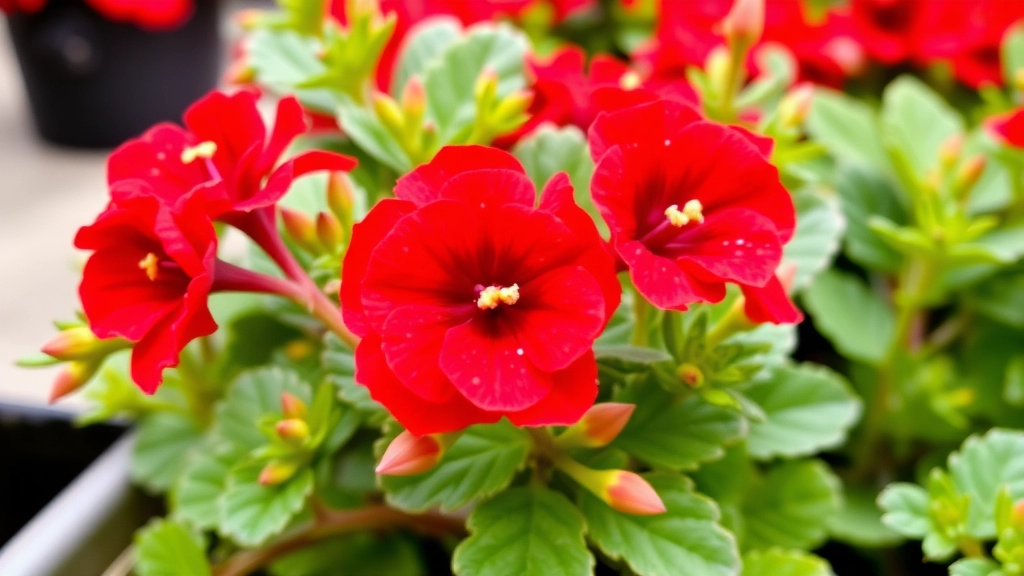Florist Kalanchoe Red: A Vibrant Addition
If you’re looking to add a splash of vibrant red to your indoor or outdoor space, the Florist Kalanchoe Red is your go-to plant. Known for its stunning, long-lasting blooms, this variety of Kalanchoe blossfeldiana, also called Flaming Katy, is a favourite among plant enthusiasts. But what does it take to keep these beauties thriving? Let’s dive into the best practices for growing and maintaining your red kalanchoe.
Ideal Conditions for Kalanchoe
First off, understanding the ideal conditions for your kalanchoe is key. These plants thrive in bright, indirect sunlight and prefer well-draining soil. Overwatering can be a common pitfall, so it’s crucial to let the soil dry out between waterings.
Propagation Tips
If you’re keen on propagation, red kalanchoe can be easily propagated from cuttings or offsets, making it a versatile addition to your plant collection. Stay tuned as we explore more tips and tricks to keep your Florist Kalanchoe Red in top shape.
Best Conditions for Growing Red Kalanchoe Indoors and Outdoors
Are you struggling to keep your red Kalanchoe thriving, whether indoors or outdoors?
Understanding the best conditions for growing this vibrant succulent can make all the difference.
Ideal Growing Conditions
Indoor Growing Conditions
- Temperature: Red Kalanchoe thrives in temperatures between 15°C and 25°C. Avoid exposing it to cold drafts or extreme heat.
- Humidity: This plant prefers low humidity, making it perfect for indoor environments. Aim for a dry atmosphere to prevent rot.
- Light: Choose a bright spot, ideally near a south-facing window. However, be cautious of direct sunlight that can scorch the leaves.
Outdoor Growing Conditions
- Location: Select a spot with partial shade or filtered sunlight. Morning sun is beneficial, while harsh afternoon rays can be detrimental.
- Soil: Well-draining soil is essential. A cactus or succulent mix works wonders for red Kalanchoe.
- Watering: Outdoor plants require less frequent watering due to natural rainfall. Ensure the soil dries out between waterings.
For more detailed guidance on growing red Kalanchoe, check out our comprehensive care guide. If you’re interested in other varieties, our Kalanchoe Blossfeldiana hybrid care tips might be useful as well.
Light Requirements for Vibrant Red Blooms
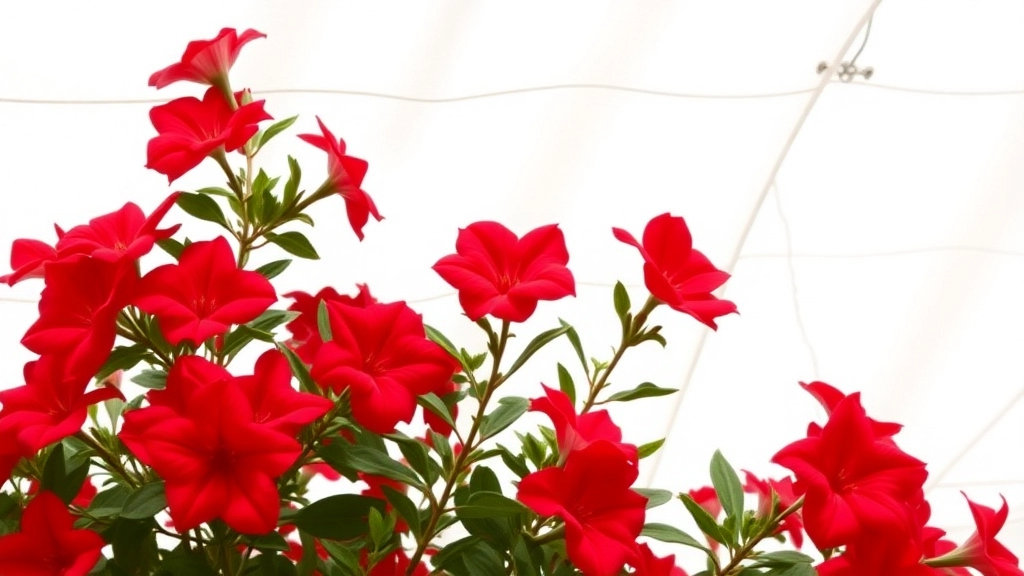
Have you ever wondered why your red kalanchoe isn’t blooming as brilliantly as you hoped?
Light plays a crucial role in the health and vibrancy of these stunning plants.
The Right Amount of Light
Kalanchoe loves bright, indirect sunlight. Here’s how to get it just right:
- Location: Place your kalanchoe near a window that gets plenty of light but avoid direct sunlight, which can scorch the leaves.
- Duration: Aim for about 6 hours of light each day. If you notice the leaves stretching towards the light, it’s a sign they need more.
- Seasonal Changes: In winter, when days are shorter, consider using a grow light to supplement their light needs.
Signs Your Kalanchoe is Happy
Keep an eye on your plant! Healthy red blooms and vibrant green leaves are signs it’s getting the right light.
If the blooms are sparse or the leaves are turning yellow, it might be time to adjust their light exposure.
Quick Tips for Light Management
- Rotate your plant every few weeks to ensure all sides get equal light.
- Watch for leggy growth, which indicates your kalanchoe is stretching for light.
When it comes to nurturing your Red Kalanchoe, the right watering schedule and soil selection are crucial for keeping your plant thriving. Many plant enthusiasts often wonder how often they should water and what type of soil is best. Let’s dive into these essential aspects.
### Watering Schedule
– **Frequency**: Kalanchoe prefers a moderate watering schedule. Water your plant when the top inch of soil feels dry to the touch. This typically translates to every 1-3 weeks, depending on the environment.
– **Signs of Overwatering**: Yellowing leaves or a mushy stem can indicate too much water. If you notice these signs, reduce your watering frequency.
– **Signs of Underwatering**: If the leaves start to wrinkle or drop, it’s time to give your Kalanchoe a drink. For more detailed guidance, you can refer to the [causes and solutions for black spots on Kalanchoe leaves](https://planthq.org/causes-and-solutions-for-black-spots-on-kalanchoe-leaves/).
### Soil Selection
– **Well-Draining Soil**: Use a cactus or succulent potting mix, which allows for proper drainage. Avoid regular potting soil, as it tends to retain too much moisture.
– **Amendments**: If you want to create your own mix, combine equal parts of potting soil, coarse sand, and perlite. This will ensure good aeration and drainage.
– **pH Level**: Kalanchoe thrives in slightly acidic to neutral soil (pH 6.0-7.0). Regularly check the pH level to maintain optimal conditions. For further reading, check out the [complete care guide for Kalanchoe Tubiflora](https://planthq.org/complete-care-guide-for-kalanchoe-tubiflora-mother-of-millions/).
### Tips for Optimal Health
– **Container Choice**: Ensure your pot has drainage holes. This prevents water from pooling at the bottom, which can lead to root rot.
– **Seasonal Adjustments**: During the growing season (spring and summer), your Kalanchoe may need more frequent watering compared to the dormant season (autumn and winter).
Propagation Techniques: From Cuttings and Offsets
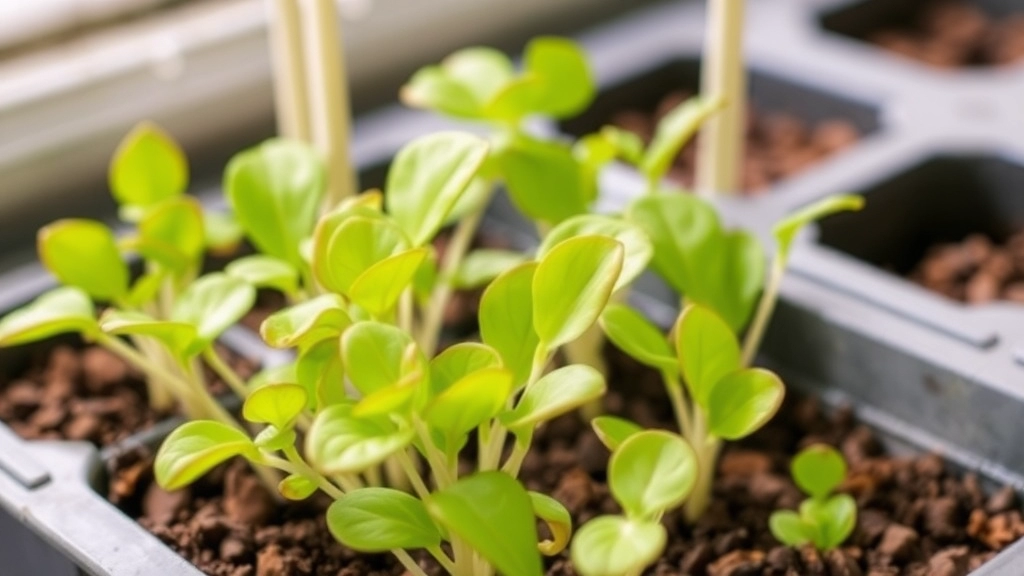
Are you looking to expand your collection of vibrant red Kalanchoe? Propagation is a fantastic way to do just that. Many enthusiasts wonder about the best methods to propagate these stunning plants effectively.
Propagation from Cuttings
- Choose Healthy Stems:
- Select a healthy stem that is at least 4 inches long.
- Ensure it has several leaves and no signs of disease or pests.
- Make the Cut:
- Use sterilised scissors to make a clean cut just below a leaf node.
- This helps prevent any infection and promotes better root growth.
- Allow to Callus:
- Place the cutting in a dry, warm location for 1-3 days.
- This allows the cut end to callus over, reducing the risk of rot.
- Planting the Cutting:
- Use a well-draining potting mix, ideally designed for succulents.
- Insert the callused end into the soil, burying it about an inch deep.
- Water Sparingly:
- Water lightly after planting, then allow the soil to dry out completely before watering again.
- Too much moisture can lead to rot.
Propagation from Offsets
- Identify Offsets:
- Offsets are small plantlets that grow around the base of the parent plant.
- Look for healthy offsets that are at least 2-3 inches tall.
- Carefully Remove:
- Gently twist or cut the offset away from the parent plant.
- Make sure to include some roots if possible.
- Let Them Dry:
- Similar to cuttings, let the offsets dry for a couple of days.
- This helps to form a protective layer over the cut area.
- Planting Offsets:
- Use a succulent mix for planting.
- Place the offset in the soil, ensuring it stands upright.
- Watering:
- Water lightly and allow the soil to dry out between waterings.
- Offsets are quite resilient but can still suffer from overwatering.
By following these straightforward propagation techniques, you can easily multiply your red Kalanchoe and enjoy their beauty in various spots around your home or garden.
How to Get Kalanchoe to Rebloom After Flowering
After enjoying the vibrant display of your Kalanchoe’s blooms, you might be wondering how to encourage it to flower again. This concern is common among plant enthusiasts, especially when faced with the challenge of getting these beautiful succulents to rebloom.
Understanding the Flowering Cycle
Kalanchoe plants typically bloom once a year, but with the right care, you can coax them into flowering again. Here are some effective strategies to consider:
- Post-Bloom Care: Once the flowers have faded, remove the spent blooms. This process, known as deadheading, helps redirect energy back into the plant.
- Light Adjustment: After flowering, your Kalanchoe needs a bit of a break. Reduce its exposure to bright light for about six weeks. A cooler, darker spot can help encourage rest.
- Watering Regime: Cut back on watering during the resting phase. Allow the soil to dry out completely between waterings. This helps simulate the dry conditions Kalanchoe prefers after blooming.
- Fertilization: Once your plant shows signs of new growth, it’s time to reintroduce fertilisation. Use a balanced, water-soluble fertilizer every two weeks during the growing season. This will help boost new flower production.
- Light Exposure for Reblooming: After the resting period, gradually reintroduce bright, indirect sunlight. This is crucial for stimulating new flower buds.
Seasonal Timing
Timing is essential. The best time to encourage reblooming is in the spring. By following the above steps, you’ll set your Kalanchoe up for success as it enters its next flowering phase.
For more detailed tips on flowering Kalanchoe care and optimal care guides, visit our website.
Managing Common Pests and Diseases in Red Kalanchoe
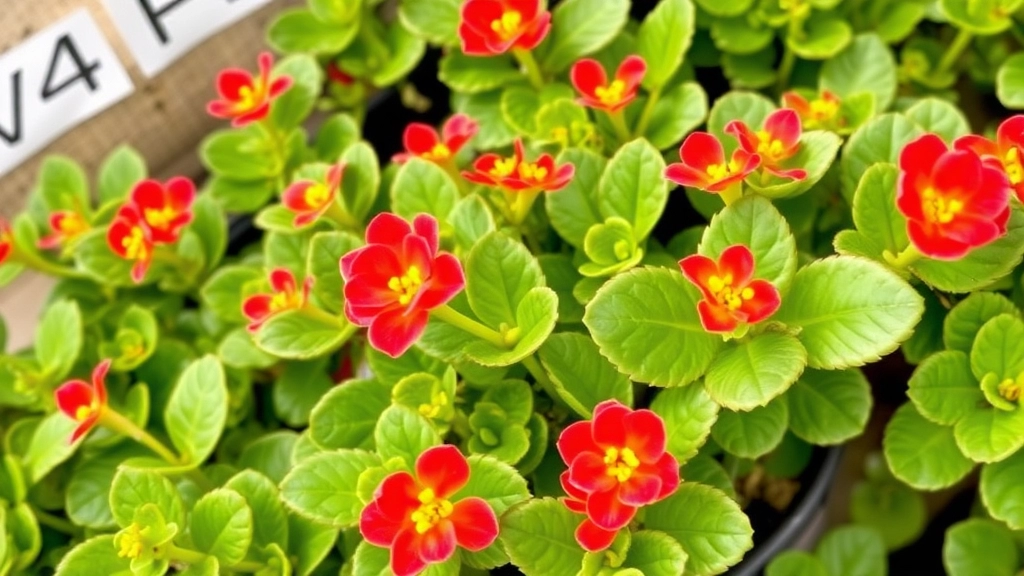
Have you noticed some unwanted guests on your beautiful red Kalanchoe? You’re not alone! Many plant lovers face the challenge of pests and diseases that can threaten the health of their beloved blooms.
Common Pests
- Mealybugs
These little white cottony bugs love to hide in leaf joints.
Tip: Wipe them off with a cotton swab dipped in rubbing alcohol. - Aphids
Tiny and often green, these pests suck the sap out of your plant.
Tip: Spray with a mixture of water and a few drops of dish soap to dislodge them. - Spider Mites
If you see fine webbing, these are your culprits.
Tip: Increase humidity around the plant and spray with water to get rid of them.
Common Diseases
- Root Rot
Caused by overwatering, this can be a real killer.
Tip: Ensure your pot has drainage holes and let the soil dry out between waterings. - Leaf Spot
Dark spots on leaves can indicate fungal infections.
Tip: Remove affected leaves and avoid overhead watering to keep leaves dry. - Powdery Mildew
A white powdery substance on leaves signals this issue.
Tip: Improve air circulation and apply a fungicide if necessary.
Prevention Tips
- Inspect Regularly: Check your Kalanchoe weekly for any signs of pests or disease.
- Maintain Good Hygiene: Clean your pots and tools to avoid spreading pests.
- Quarantine New Plants: Keep any new additions away from your existing plants for a couple of weeks.
Choosing Fertilizers to Boost Flowering in Red Kalanchoe
When it comes to ensuring your red Kalanchoe blooms vibrantly, the right fertilizer can make all the difference. Many plant lovers often wonder, “What should I use to encourage more flowers?” Here’s how to effectively choose fertilizers that will enhance flowering and overall plant health.
Pruning and Maintenance Tips for Red Florist Kalanchoe
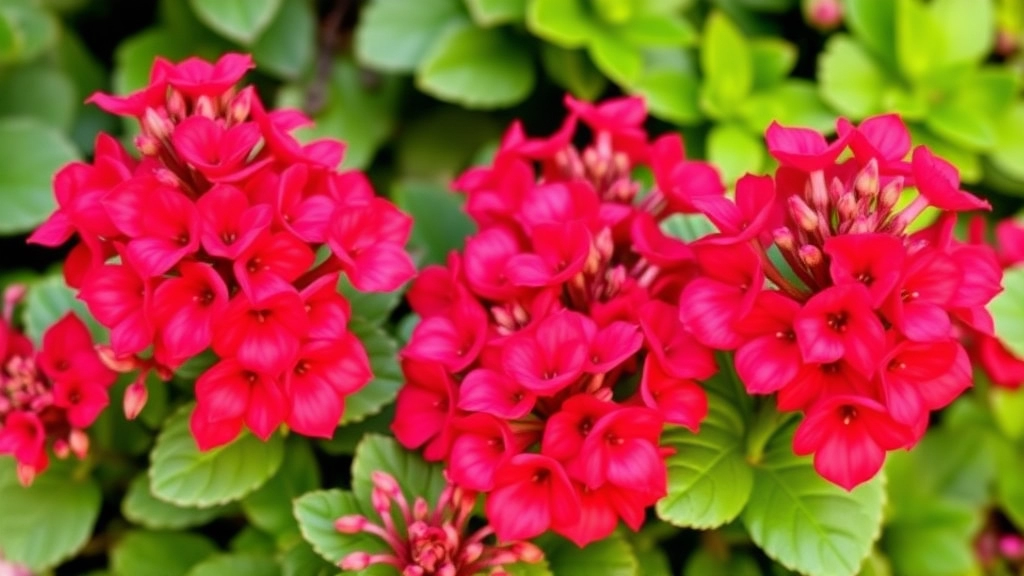
So, you’ve got your stunning Red Kalanchoe, and now you’re wondering how to keep it looking fabulous, right? Pruning and maintenance are key to ensuring your plant thrives and continues to bloom vibrantly.
Why Prune?
Pruning isn’t just about aesthetics; it helps your Kalanchoe grow stronger and healthier. By removing dead or wilted leaves, you’re allowing the plant to focus its energy on new growth and blooms.
When to Prune
- After Flowering: Once the blooms fade, it’s time to trim back.
- Regular Maintenance: Keep an eye on any dead or yellowing leaves throughout the year.
How to Prune
- Use Clean Tools: Always use sharp, clean scissors or pruning shears to avoid infection.
- Cut at the Base: Trim wilted flowers and leaves at the base to encourage fresh growth.
- Shape the Plant: Aim for an even shape by cutting back any overly long stems.
Maintenance Tips
- Dust Off Leaves: Wipe the leaves with a damp cloth to keep them dust-free and allow for better light absorption.
- Rotate Your Plant: Give it a gentle twist every few weeks to ensure even light exposure.
- Check for Pests: Regularly inspect for any signs of pests or diseases, especially after pruning.
Bonus Tips
- Timing: The best time to prune is in early spring when the plant is gearing up for its growing season.
- Don’t Overdo It: A little pruning goes a long way. Too much can stress the plant.
Cold Weather Care: Bringing Kalanchoe Indoors
As we transition into the colder months, many plant enthusiasts worry about how to protect their beloved red Kalanchoe.
Why Bring Kalanchoe Indoors?
Kalanchoe, while hardy, is sensitive to frost and extreme cold. If left outdoors, it can suffer damage or even perish. Here are some key considerations for bringing your Kalanchoe indoors safely:
- Timing:
- Monitor local temperatures.
- Bring your Kalanchoe indoors when nighttime temperatures consistently drop below 10°C (50°F).
- Location:
- Choose a bright spot near a window.
- Avoid areas with cold drafts or direct heat sources, such as radiators.
- Acclimatization:
- Gradually introduce your Kalanchoe to indoor conditions over a week.
- This helps the plant adjust to changes in light and temperature.
Indoor Care Tips
Once indoors, your Kalanchoe will need some adjustments in care:
- Light:
- Ensure it receives at least 6 hours of indirect sunlight daily.
- If natural light is limited, consider using grow lights.
- Watering:
- Reduce watering frequency.
- Allow the soil to dry out between waterings to prevent root rot.
- Humidity:
- Kalanchoe prefers lower humidity.
- Avoid placing it in overly humid areas, such as bathrooms.
- Temperature:
- Maintain a consistent indoor temperature between 15°C to 21°C (59°F to 70°F).
For more detailed advice, check out our Optimal Care for Kalanchoe Blossfeldiana Growth guide. Additionally, if you’re dealing with specific issues like etiolated plants, our Fixing Etiolated Kalanchoe Blossfeldiana tips might be helpful.
Styling Ideas for Using Red Kalanchoe in Floral Arrangements

So, you’ve got those stunning red Kalanchoe plants, and you’re wondering how to showcase them, right?
Let’s dive into some creative styling ideas that’ll make your arrangements pop.
1. Mix and Match with Other Plants
- Pair Kalanchoe with contrasting greens like ferns or ivy for a vibrant look.
- Combine with succulents of varying shapes and sizes for a modern twist.
2. Use Unique Containers
- Think outside the traditional pot! Use vintage teacups, mason jars, or even wooden crates.
- Metallic or ceramic pots can add a touch of elegance.
3. Create a Centrepiece
- A cluster of Kalanchoe in varying heights can make a stunning table centrepiece.
- Add candles or fairy lights around the arrangement for a cozy vibe.
4. Vertical Gardens
- Mount Kalanchoe in wall planters for a lively vertical garden.
- Mix with trailing plants to create depth and interest.
5. Seasonal Displays
- Use Kalanchoe in holiday arrangements by adding ornaments or seasonal foliage.
- For spring, pair with pastel flowers for a fresh look.
6. Terrariums
- Create a mini-ecosystem with Kalanchoe in a glass terrarium.
- Add decorative stones or sand for a layered effect.
7. Gift Ideas
- Kalanchoe makes a lovely gift! Arrange in a pretty box or basket.
- Include a personal note for that extra touch.
Best Practices for Long-Lasting Blooms in Kalanchoe
Are you frustrated with your Kalanchoe blooms fading too quickly? You’re not alone; many plant enthusiasts face this issue.
To ensure your red Kalanchoe flowers last as long as possible, consider these best practices:
Optimal Light Conditions
- Bright, Indirect Light: Place your Kalanchoe in a spot with plenty of bright, indirect sunlight. This encourages vibrant blooms.
- Avoid Direct Sunlight: Too much direct sun can scorch the leaves and reduce flowering.
Watering Wisely
- Soil Drying: Allow the top inch of soil to dry out before watering again. Overwatering can lead to root rot.
- Watering Frequency: During the growing season, water every 2-3 weeks. In winter, reduce to once a month.
Fertilisation
- Balanced Fertiliser: Use a balanced, water-soluble fertiliser every 4-6 weeks during the growing season to promote blooming.
- Dilute Strength: Always dilute the fertiliser to half the recommended strength to prevent burning the roots.
Pruning for Growth
- Deadheading: Remove spent blooms to encourage new growth and prolong flowering.
- Regular Pruning: Trim back leggy growth to maintain a bushy appearance, which helps the plant focus energy on blooming. For more detailed tips, check out our guide on pruning Kalanchoe plants.
Temperature Control
- Ideal Range: Keep your Kalanchoe in a temperature range of 18-24°C (65-75°F). Avoid sudden temperature drops.
- Avoid Drafts: Keep your plant away from cold drafts or heating vents.
Humidity Levels
- Moderate Humidity: Kalanchoe prefers moderate humidity. If your home is too dry, consider using a pebble tray with water to increase moisture levels. For additional care tips, visit our complete guide to caring for Kalanchoe succulents.
FAQs on Florist Kalanchoe Red
What are the light requirements for red Kalanchoe to bloom vibrantly?
Red Kalanchoe thrives in bright, indirect sunlight. Aim for about 6 hours of light daily, and consider using a grow light in winter when days are shorter.
How can I tell if my red Kalanchoe is getting enough light?
Healthy red blooms and vibrant green leaves indicate proper light exposure. If you notice sparse blooms or yellowing leaves, it may need more light.
What are the best methods to propagate red Kalanchoe?
Propagation can be done through cuttings or offsets. For cuttings, use a healthy stem, let it callus, and plant in well-draining soil. For offsets, remove plantlets from the base, let them dry, and plant similarly.
How do I manage common pests on my red Kalanchoe?
Common pests include mealybugs, aphids, and spider mites. Use rubbing alcohol for mealybugs, a water-dish soap mix for aphids, and increase humidity for spider mites.
What are the common diseases that affect red Kalanchoe, and how can I prevent them?
Common diseases include root rot, leaf spot, and powdery mildew. Prevent these by ensuring proper drainage, avoiding overhead watering, and maintaining good air circulation.
When and how should I prune my red Kalanchoe?
Prune after flowering and regularly remove dead or yellowing leaves. Use clean tools and trim at the base to encourage new growth. Shape the plant for an even appearance.
Can I use red Kalanchoe in floral arrangements?
Yes, red Kalanchoe can be creatively styled in arrangements. Pair with contrasting greens, use unique containers, create centerpieces, or even incorporate them into vertical gardens and terrariums.
What are some styling ideas for red Kalanchoe in floral arrangements?
Mix with other plants, use unique containers, create centerpieces, make vertical gardens, design seasonal displays, build terrariums, and consider them as thoughtful gifts.
How often should I water my red Kalanchoe?
Water sparingly. Allow the soil to dry out completely between waterings to prevent root rot. Overwatering is a common issue.
What should I do if my red Kalanchoe shows signs of pests or diseases?
Inspect regularly and take immediate action. Use appropriate treatments like rubbing alcohol for pests and fungicides for diseases. Maintain good plant hygiene and quarantine new plants.
References
-
How to grow kalanchoe
-
Kalanchoe Plant Care Guide
-
Kalanchoe: How to Grow and Care for Kalanchoe
